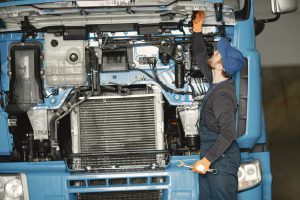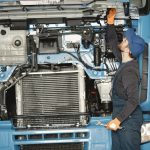For truck owners and operators, the engine is more than just a machine; it’s the lifeline that keeps operations moving, deadlines met, and profits on track. But even the toughest engines can face wear and tear, especially with the demands of long hauls, heavy loads, and daily grind.
If you’ve ever dealt with an unexpected breakdown or nagging engine issue, you know the frustration it brings—not to mention the impact on your schedule and budget. In this blog, we’ll explore the most common truck engine problems, uncover their root causes, and share practical solutions to get your truck back on the road. Plus, we’ll highlight essential replacement components that can make all the difference in ensuring your truck runs like a well-oiled machine.
- Overheating Engine
Problem: Overheating is one of the most frequent truck engine issues. It can occur due to a failing water pump, damaged seals, or inadequate coolant levels. Prolonged overheating may lead to significant engine damage.
Solution:
- Regularly check coolant levels and ensure there are no leaks in the cooling system.
- Inspect and replace damaged water pumps and seals to maintain efficient cooling.
- Perform periodic flushing of the radiator to remove buildup and maintain efficient cooling.
- Poor Engine Compression
Problem: Engine compression issues arise when the cylinders cannot maintain the necessary pressure for combustion. This can lead to misfires, a lack of power, or difficulty starting.
Solution:
- Diagnose the problem by conducting a compression test.
- Replace worn or damaged gaskets to restore proper sealing.
- Check and replace valve seats if they are contributing to the compression loss.
- Valve Malfunctions
Problem: Engine valves are crucial for controlling the intake of air and fuel and the expulsion of exhaust gases. Problems such as sticking valves or weak valve springs can reduce engine efficiency or cause misfires.
Solution:
- Regularly inspect valve components for wear and tear.
- Replace faulty valves, valve guides, and valve springs to ensure proper function.
- Perform routine maintenance to prevent debris from clogging valve components.
- Injector Leaks
Problem: Injector sleeve leaks can disrupt fuel delivery, causing poor engine performance, reduced fuel economy, and increased emissions.
Solution:
- Inspect injector sleeves for signs of wear or leaks.
- Replace damaged or worn injector sleeves to restore efficient fuel delivery.
- Ensure injectors are cleaned periodically to prevent blockages.
- Camshaft Bushing Wear
Problem: Worn or damaged camshaft bushings can result in engine knocking, poor timing, and reduced overall performance.
Solution:
- Regularly inspect camshaft bushings for wear.
- Replace worn bushings promptly to prevent further damage to the camshaft or engine block.
- Lubricate components as recommended to reduce friction and wear.
- Weak Valve Spring Retainers
Problem: Weak or broken valve spring retainers can lead to improper valve operation, reducing engine performance and potentially causing long-term damage.
Solution:
- Replace broken or weak retainers during regular maintenance.
- Use high-quality replacements designed for heavy-duty truck engines.
- Test the tension of valve springs periodically to identify potential failures.
- Engine Oil Leaks
Problem: Engine oil leaks are common and can result from worn gaskets or seals. Oil leaks can reduce lubrication, leading to overheating and increased wear on engine components.
Solution:
- Identify the source of the leak, whether it’s the gasket, seal, or another component.
- Replace the faulty part to prevent further oil loss.
- Regularly check oil levels and top up as necessary.
- Faulty Water Pump
Problem: A failing water pump can reduce coolant circulation, causing overheating and other cooling-related problems.
Solution:
- Inspect the water pump for leaks, noises, or reduced performance.
- Replace the pump if it shows signs of wear or damage.
- Ensure proper installation and use of high-quality replacement parts.
- Worn Valve Stem Seals
Problem: Valve stem seals can wear over time, leading to excessive oil consumption and smoke from the exhaust.
Solution:
- Replace worn valve stem seals during engine maintenance.
- Use compatible seals to prevent oil leakage into the combustion chamber.
- Monitor oil levels frequently to detect excessive consumption early.
- Damaged Piston Pin Bushings
Problem: Piston pin bushings are essential for keeping the piston and connecting rod in perfect alignment. These components are constantly stressed during engine operation, and they might wear out over time owing to inadequate lubrication, severe loads, or low-quality materials. Damaged bushings can result in banging noises, vibrations, and decreased engine performance. If left untreated, they can cause significant wear on the connecting rod and piston pin, resulting in expensive repairs or engine failure.
Solution:
- Inspect bushings for signs of wear or misalignment.
- Replace damaged bushings to maintain smooth engine operation.
- Use properly sized and durable replacements to prevent recurring issues.
Preventive Measures to Avoid Truck Issues
While these common issues can be addressed with the right replacement parts and maintenance, prevention is always better than repair. Here are some tips to reduce the likelihood of engine problems:
- Regular Maintenance: Stick to a consistent maintenance schedule, including oil changes, filter replacements, and coolant flushes.
- Use Quality Parts: Invest in high-quality components to extend the lifespan of your truck’s engine.
- Monitor Performance: Pay attention to unusual noises, vibrations, or performance drops, and address them promptly.
- Proper Storage: If the truck will be unused for extended periods, ensure it is stored properly to prevent rust and damage to engine components.
Truck engines are intricate systems that demand attention and upkeep. Understanding these typical concerns and taking necessary action will preserve your truck’s reliability and efficiency for years to come.








